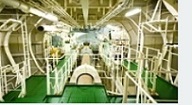
Bulk CO2 fire fighting system for cargo ships
There may be a variety of different fixed fire fighting installations exist, some of which are specifically designed for certain types of ship.
Fig explained an installation of bulk CO2 system. It consists of a large vessel which holds CO2 at a working pressure of around 21 bar and temperature of minus 20°C. To maintain these parameters,
a dual refrigeration system is employed and controlled by
the CO2 pressure in the vessel. One refrigeration system is
in operation while the other is on standby.


